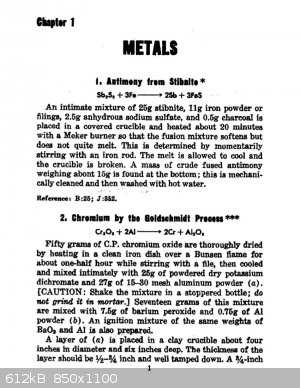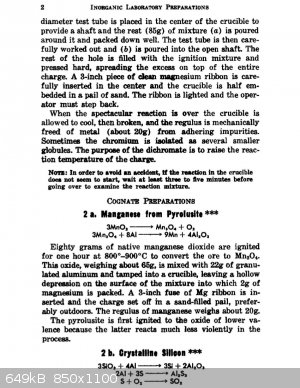Foeskes
Hazard to Others
  
Posts: 156
Registered: 25-2-2017
Member Is Offline
Mood: No Mood
|
|
Making chromium metal?
I'm thinking of making chromium metal at some point.
According to Wikipedia chromium is made by alumothermic reduction of chromium oxide, however after seeing nurdrage's video on chromium thermite it
doesn't look like its very viable. Maybe it will work if I add some kind of booster, but I'm not sure which booster to use, maybe sulfur and
Aluminium? I also saw someone use potassium dichromate and Aluminium as a booster, not sure if it will form chromium nuggets though.
|
|
|
JJay
International Hazard
    
Posts: 3440
Registered: 15-10-2015
Member Is Offline
|
|
Schlessinger (in the SM library) suggested adding some potassium dichromate to the mix to raise the temperature of the reaction. He also suggested
using a barium peroxide/aluminum mixture for ignition. I'm not sure if that's really necessary or if magnesium powder would work just as well.
 
|
|
|
Foeskes
Hazard to Others
  
Posts: 156
Registered: 25-2-2017
Member Is Offline
Mood: No Mood
|
|
Also what is a good way of producing chromium(III) oxide from Potassium dichromate?
|
|
|
ninhydric1
Hazard to Others
  
Posts: 345
Registered: 21-4-2017
Location: Western US
Member Is Offline
Mood: Bleached
|
|
http://www.sciencemadness.org/talk/viewthread.php?tid=21562#...
Instead of sodium hydroxide, use potassium hydroxide.
|
|
|
unionised
International Hazard
    
Posts: 5102
Registered: 1-11-2003
Location: UK
Member Is Offline
Mood: No Mood
|
|
I think you are heading in the wrong direction.
You can make Cr(OH)3 by dissolving chromate in dilute acid and reacting it with alcohol or sodium bisulphite to reduce it to Cr(III) and then add
sodium hydroxide to ppt the Cr(OH)3
If you have ammonium dichromate you can do this
https://www.youtube.com/watch?v=Ula2NWi3Q34
|
|
|
JJay
International Hazard
    
Posts: 3440
Registered: 15-10-2015
Member Is Offline
|
|
I think you can convert chromium hydroxide to chromium oxide by heating it in a crucible. I haven't actually tried it and don't have a reference, but
it seems reasonable to suppose that would work.
If not, you can react it with sulfuric acid and convert it to chromium sulfate and heat that to convert it to chromium oxide.
|
|
|
Foeskes
Hazard to Others
  
Posts: 156
Registered: 25-2-2017
Member Is Offline
Mood: No Mood
|
|
What if you mix chromate with sugar or charcoal and ignite?
Can sodium thiosulfate be used? Because sodium bisulfite is not sold anywhere here.
Or maybe glucose?
[Edited on 9-7-2017 by Foeskes]
|
|
|
ave369
Eastern European Lady of Mad Science
   
Posts: 596
Registered: 8-7-2015
Location: No Location
Member Is Offline
Mood: No Mood
|
|
It is easy to make chromium (III) oxide from ammonium dichromate. Just set it in fire and watch the fireworks. The green ash will be the desired
oxide. It will be unreactive and useless for wet chemistry, but good enough to use in a thermite.
Smells like ammonia....
|
|
|
Foeskes
Hazard to Others
  
Posts: 156
Registered: 25-2-2017
Member Is Offline
Mood: No Mood
|
|
What do you mean by "unreactive"?
Is it due to impurities or the structure?
[Edited on 11-7-2017 by Foeskes]
|
|
|
elementcollector1
International Hazard
    
Posts: 2684
Registered: 28-12-2011
Location: The Known Universe
Member Is Offline
Mood: Molten
|
|
I would imagine it's largely due to the structure - the elevated temperatures induce calcination in oxides, which renders them much less reactive than
drying at lesser temperatures. However, in the molten state where thermite typically takes place, this doesn't matter at all.
Elements Collected:52/87
Latest Acquired: Cl
Next in Line: Nd
|
|
|
Praxichys
International Hazard
    
Posts: 1063
Registered: 31-7-2013
Location: Detroit, Michigan, USA
Member Is Offline
Mood: Coprecipitated
|
|
If you're looking for an element sample, aluminothermic reactions are not the way to go. You'll only end up with some rather ugly gray chromium
nodules/powder.
You could try common Cr+6 or Cr+3 plating methods to electroplate chromium onto an electrode, then flake it off.
If you're just looking for chromium, you can chuck a mix of aluminum powder and chromium III oxide in an open-top steel pipe with a large (3x or more
by stoicheometry) excess of aluminum. Place this in a bonfire and keep it at red heat for a while. The aluminum will melt and reduce the oxide to
chromium, forming a sintered cake of aluminum oxides, aluminum, and chromium. Crush this up and stir it into hot HCl and everything except the
chromium metal will dissolve.
|
|
|
elementcollector1
International Hazard
    
Posts: 2684
Registered: 28-12-2011
Location: The Known Universe
Member Is Offline
Mood: Molten
|
|
Quote: Originally posted by Praxichys  | If you're looking for an element sample, aluminothermic reactions are not the way to go. You'll only end up with some rather ugly gray chromium
nodules/powder.
|
I wouldn't know about that, mine turned out lovely - a bit shinier than freshly broken metal.
I would think that purity is the main concern when going after element samples through thermite reduction, as too much aluminum or magnesium can
dissolve in your metal sample, contaminating it. However, too little of your reducing agent can cause the mix to be much harder to ignite...
Elements Collected:52/87
Latest Acquired: Cl
Next in Line: Nd
|
|
|
Foeskes
Hazard to Others
  
Posts: 156
Registered: 25-2-2017
Member Is Offline
Mood: No Mood
|
|
Quote: Originally posted by Praxichys  | If you're looking for an element sample, aluminothermic reactions are not the way to go. You'll only end up with some rather ugly gray chromium
nodules/powder.
You could try common Cr+6 or Cr+3 plating methods to electroplate chromium onto an electrode, then flake it off.
If you're just looking for chromium, you can chuck a mix of aluminum powder and chromium III oxide in an open-top steel pipe with a large (3x or more
by stoicheometry) excess of aluminum. Place this in a bonfire and keep it at red heat for a while. The aluminum will melt and reduce the oxide to
chromium, forming a sintered cake of aluminum oxides, aluminum, and chromium. Crush this up and stir it into hot HCl and everything except the
chromium metal will dissolve. |
I thought HCl dissolves Cr quite well.
|
|
|